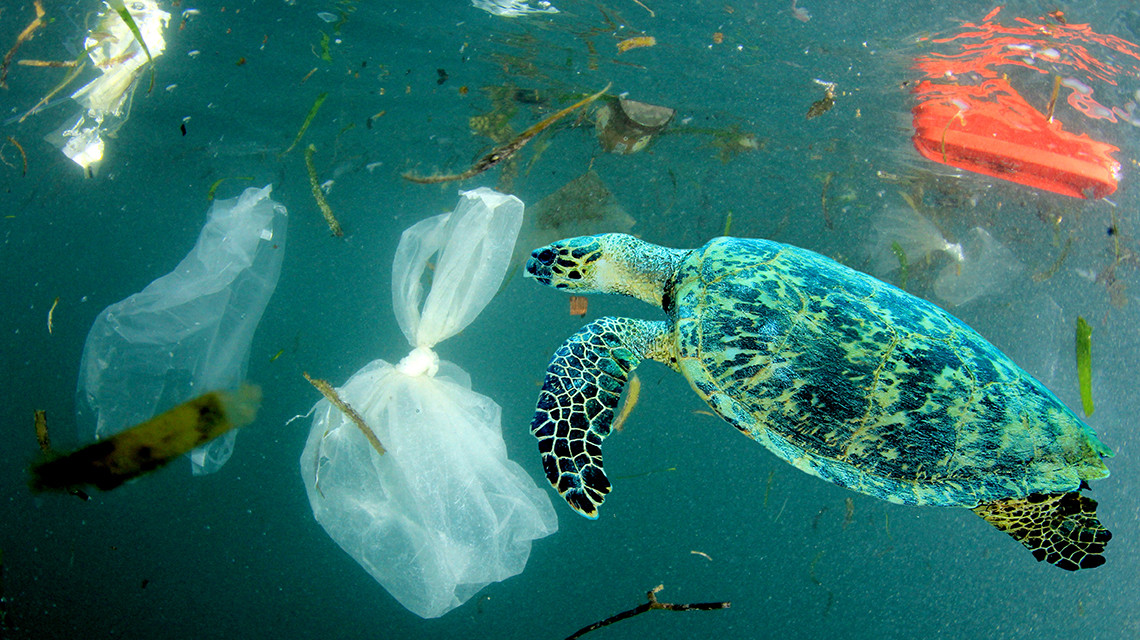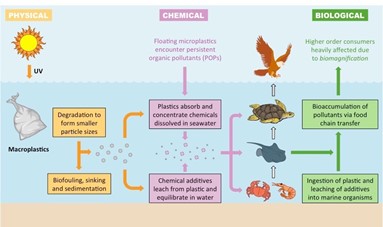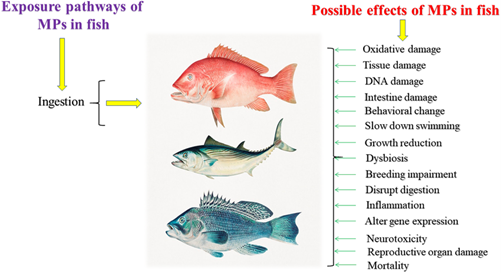Microplastics: An Invisible Threat to Marine Life

Photo Credit : Richard Carey/Stock.Adobe.com
Microplastics are plastic particles that are less than five millimeters in size. Microplastics themselves are divided into two main categories: primary microplastics and secondary microplastics, Microbeads which are one of the primary microplastic elements are found in consumerist products such as scrub soap and toothpaste, while secondary microplastics come from various human activities that cause the fragmentation of larger plastic products and also poorly managed plastic waste that can eventually end up in the ocean and decompose into microplastics under the influence of UV rays and water movement.
Microplastics reach the ocean through a variety of pathways, including urban drainage systems and rivers. Study by Lebreton et al. (2017) found that large rivers are the main source of microplastic transport to the ocean.
The Impact of Microplastics on Marine Life
The flow of microplastics in the body of marine life is a complex process that involves various mechanisms of absorption, distribution, and accumulation. Marine organisms such as fish and crustaceans can consume microplastics that float in the water. These particles then accumulate in their bodies, which can move to larger predators in the food chain. Study by Rochman et al (2015) showed that fish exposed to microplastics showed higher levels of stress and liver damage.
Plastic waste containing additives has the potential to be the main source chemical contamination in remote areas. Microplastics carry toxic chemicals such as BPA and PCBs that can escape into the body of marine life. Research by Tanaka et al. in (2013, 2016 and 2023) reported how the chemicals accumulated in crabs and fish could affect the reproductive function and growth of marine organisms.
How microplastics interact with marine organisms can go through several grooves, namely:
Microplastic Absorption

Plastic debris in marine environment (Photo Credit : Bioninja)
- Ingestion: Microplastics can be consumed by marine life either directly or indirectly. Directly, organisms such as fish, crustaceans, and mollusks consume microplastics that they mistake for food due to their similar size and shape to plankton or small fish. Indirectly, microplastics are absorbed when animals eat prey that has consumed plastic.
- Respiration: For species that filter water, such as oysters and shellfish, microplastics can enter the body through the process of filtering food. Microplastic particles suspended in the water are trapped in the gills as the water is filtered to capture plankton and other organic particles.
Distribution and Accumulation
- Transport in the Body: Once in the body, microplastics can move from the digestive system to other organs and tissues. Studies have shown that microplastic particles can penetrate the intestinal wall and enter the bloodstream, allowing them to be distributed throughout the body.
- Bioaccumulation: Microplastics tend to accumulate in the bodies of marine organisms over time. Because these particles are highly resistant to biological degradation, they can persist in the body for long periods. This accumulation becomes more concentrated at higher trophic levels in the food chain, a process known as biomagnification.
- Interactions with Tissues and Organs: Microplastics can cause physical and chemical damage to tissues. Physical, due to the size and roughness of particles can irritate or injure soft tissues. Chemicals, because microplastics often bind or adsorb harmful pollutants such as heavy metals, PCBs, and DDT from the environment, which can be released into the organism's body.
Effects of Toxicology</strong

Possible effect of microplastics in fish body after ingestion (Photo Credit : Md. Simul Bhuyan)
- Health Effects: Exposure to microplastics can cause a variety of health problems in marine life, including inflammation, reduced organ function, and even death. Chemical additives in plastics can also disrupt the endocrine system, affecting the fertility and growth of organisms.
- Immune Response: Marine organisms can initiate an immune response to microplastics that are considered foreign bodies. This can cause oxidative stress and inflammation that further interferes with the health and fitness of the organism.
Ecological Implications and Effects on Marine Ecosystems
The influence of microplastics on marine life not only impacts contaminated individuals but also marine ecosystems as a whole. Disruption at the individual level can reduce survival and fertility, which impacts populations and community structures within ecosystems. In addition, changes to the behavior and health of marine life due to microplastics can alter predator-prey interactions and competition in the food chain, potentially altering entire ecosystems.
Declining biodiversity and a domino effect on marine ecosystems are some of the serious consequences of microplastic pollution. Phytoplankton, which is the basis of the seafood chain, is also affected, resulting in a decline in overall ocean productivity. As stated by Nengsi and Mokodompit (2024), plastic waste has caused damage to coral reef and mangrove habitats.
Global Initiatives and Policies
Governments in various countries have begun to implement policies to reduce the use of single-use plastics. The European Union, for example, has banned the use of single-use plastics and promoted the use of materials that are recyclable and more environmentally friendly.
New technologies that can detect and remove microplastics from waters are being developed. One example is the use of nanotechnology to absorb microplastic particles from seawater, which is still in the research stage but shows great potential.
The Role and Action of the Community
Public awareness and active participation in reducing the use of plastics are key. Initiatives such as more effective recycling programs and the use of environmentally friendly products can help reduce the amount of plastic that ends up in the ocean.
-Yuni Sulaiman
References
Lebreton, L. C. M., Van Der Zwet, J., Damsteeg, J. W., Slat, B., Andrady, A., & Reisser, J. (2017). River plastic emissions to the world's oceans. Nature Communications, 8, 1–10. https://doi.org/10.1038/ncomms15611
Rochman, C. M., Kross, S. M., Armstrong, J. B., Bogan, M. T., Darling, E. S., Green, S. J., Smyth, A. R., & Veríssimo, D. (2015). Scientific Evidence Supports a Ban on Microbeads. Environmental Science and Technology, 49(18), 10759–10761. https://doi.org/10.1021/acs.est.5b03909
Tanaka, K., & Takada, H. (2016). Microplastic fragments and microbeads in digestive tracts of planktivorous fish from urban coastal waters. Scientific Reports, 6(September), 1–8. https://doi.org/10.1038/srep34351
Nengsi, W., & Mokodompit, E. A. (2024). Plastic Waste in Coastal and Marine Waters: Implications for the Coastal Ecosystem of DKI Jakarta. Almufi Journal of Social and Humanities, 1(3), 362-370.
Nana Tanaka a, Naohiko Takada a, Mami Takahashi a, Bee Geok Yeo a, Yuki Oya b, Izumi Watanabe b, Yoshihisa Fujita c, Hideshige Takada a, Kaoruko Mizukawa a (2023). Bioaccumulation and metabolism of polybrominated diphenyl ethers (PBDEs) in coenobitid hermit crabs from marine litter-polluted beaches in remote islands, Marine Pollution Bulletin, Vol 190, 2023

